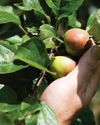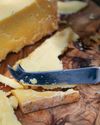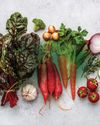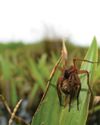
The first time Aidan Maccormick ever saw a tauros, he was at a breeding facility in the Netherlands. He doesn't quite describe it as a life-changing moment, but it certainly left a deep impression on him.
"There was this dominant bull wandering around and vocalising - it was annoyed because a younger bull was herding a couple of females away," Maccormick, who works for the Northwoods Rewilding Network, recalls. "Meanwhile, there were a couple of Exmoor pony stallions rearing up and fighting. The hairs on the back of my neck were standing up; it was like going back in time - like looking at a cave painting."
The tauros - wild-looking, muscular beasts with long horns - were bred from domesticated cattle and genetically at least were nothing to get excited about. But what they resembled and how they were behaving? That's a different matter. That's because tauros cattle have been bred to resemble, as closely as possible, the extinct wild ancestor of all domestic cattle, the aurochs, an animal many people will recognise instinctively from the depictions drawn by our ancestors in caves such as Lascaux in the Dordogne some 20,000 years ago.
Of course, those Stone Age humans hunted the aurochs for food and over time became just too damn good at it. The prehistoric megafauna slowly disappeared, and their gradual extermination was further assisted as the hunters settled down and converted wild habitats into farmland.
LAST OF THE AUROCHS
By the modern historical age, the species had been wiped out from most of its original range of North Africa, Western Asia (as far east as India) and Europe, and was confined to Central Europe, where woodland clearances between the 9th and 12th centuries were more or less the last rites. The last-known female aurochs died in a Polish forest in 1627.
Denne historien er fra August 2024-utgaven av BBC Countryfile Magazine.
Start din 7-dagers gratis prøveperiode på Magzter GOLD for å få tilgang til tusenvis av utvalgte premiumhistorier og 9000+ magasiner og aviser.
Allerede abonnent ? Logg på
Denne historien er fra August 2024-utgaven av BBC Countryfile Magazine.
Start din 7-dagers gratis prøveperiode på Magzter GOLD for å få tilgang til tusenvis av utvalgte premiumhistorier og 9000+ magasiner og aviser.
Allerede abonnent? Logg på

Guilt-Free Meat? - Should the world stop eating meat to tackle the climate crisis? Chris Baraniuk meets an experimental farmer who says we don't all have to become vegetarians
Should the world stop eating meat to tackle the climate crisis? Chris Baraniuk meets an experimental farmer who says we don't all have to become vegetarians. Livestock farming around the world is facing scrutiny because of its greenhouse gas emissions. Globally, the sector contributes somewhere between 11.1% and 19.6% of total emissions. Meat production is roughly twice as bad as the production of plant-based food, according to some analyses. And beef is the worst of all. Study after study has suggested that, in order to curtail the devastating effects of climate change, we ought to shift to a diet containing less meat - or even go vegetarian or vegan.

Discover Cider Country - Explore mellow golden countryside, pedalling between medieval villages, historic inns and fruitful orchards, on a delightful Herefordshire Cider Circuit adventure with Julie Brominicks
Explore mellow golden countryside, pedalling between medieval villages, historic inns and fruitful orchards, on a delightful Herefordshire Cider Circuit adventure with Julie Brominicks. I'm cycling Porter's Perfection, one of three cider circuits developed for Visit Herefordshire over the past few years. Each showcases a section of this bucolic county's loveliest villages, pubs, orchards and cidermakers via lanes suited to bicycles - e-bikes for hill-averse cyclists like me. The idea is to allow you to appreciate the sights, sounds and smells of cider country while traversing roads never meant for modern cars. If you have dodgy knees, or are keen to indulge in the local adult apple juice as you go (remember, it's illegal to cycle while under the influence), Visit Herefordshire also promotes cider bus routes.

TOP 10 WILD AUTUMN FOODS
Make the most of seasonal abundance with foraging tips and recipe ideas from wild food expert Liz Knight

The taste of England
Amid pastures farmed by her family for more than four centuries, Mary Quicke is reviving forgotten dairy traditions to produce delicious Devon cheeses

How to eat 30 plants a week
As science proves the many health-boosting benefits of eating at least 30 different plants each week, Hugh Fearnley-Whittingstall shares recipes to help you meet the magic target

RARE RAFT SPIDER MAKES A COMEBACK
Thanks to dedicated conservation work, this impressive but vulnerable arachnid is resurgent in East Anglia

SPECTACULAR STONEHENGE FINDS
Following the latest astonishing revelation about the Stonehenge Altar Stone's Scottish origins, Dixe Wills looks at recent discoveries that have changed the way we view this impressive and enigmatic Neolithic monument

GALLOWAY NATIONAL PARK DEBATE
Would this protected status bring welcome recognition and attention - or overcrowding and problems for farmers?

Farmers are valued, so why do they feel we don't care?
For farmers out in their fields in all seasons, worried about the future as dramatic levels of rainfall blamed on climate change damage their crops, inflation and uncertainty push up their costs and what they see as unfair imports threaten their livelihoods, here's a spot of unexpectedly good news: the rest of us think you are doing a good job.

Pumpkin patches
Find the perfect jack-o'-lantern for Halloween at a pick-your-own pumpkin patch. Some are simple affairs in tranquil countryside; others offer activities ranging from ghost trains to spooky mazes.